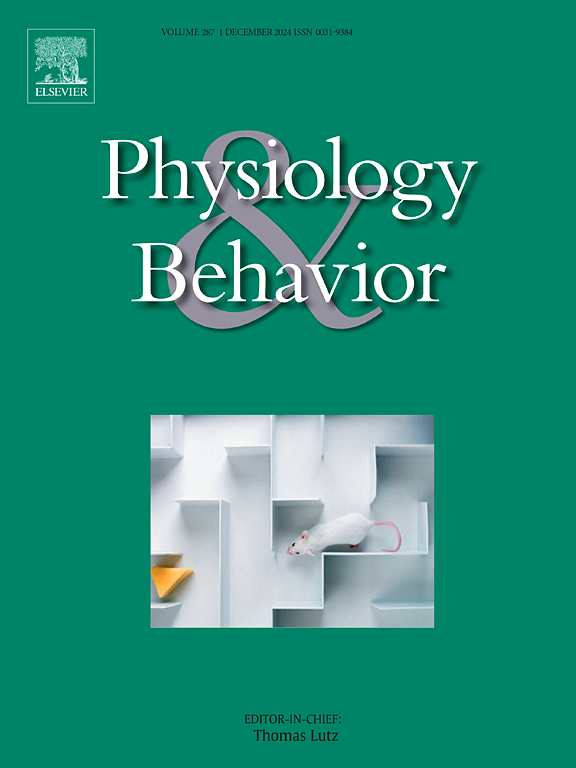Early-life vocalizations and adult auditory brainstem responses in California mice (Peromyscus californicus)
IF 2.5
3区 医学
Q2 BEHAVIORAL SCIENCES
引用次数: 0
Abstract
Mammalian infants rely on vocalizations to elicit care from their parents. In adult females, behavioral and neural responses to infant cries may change during the onset of motherhood; however, parenthood-associated plasticity in auditory processing is not well understood, especially in fathers. We characterized pup vocalizations from postnatal day (PND) 1 to PND 21 in biparental California mice (Peromyscus californicus) and assessed auditory brainstem responses to pure tones in adult virgins and parents of both sexes to test the hypothesis that auditory processing changes with the onset of parenthood, particularly in response to pup-relevant sound frequencies. Pups’ call rate dropped sharply after PND 13, and pups from smaller litters vocalized more than pups from larger litters. Syllable duration was significantly shorter at PND 16–21 than all other ages. Overall, the minimum frequency of vocalizations and minimum, fundamental, and harmonic frequency power increased with age. Minimum frequency was highest after PND 10, and power for all frequencies peaked at PND 13–15. Hearing thresholds for 24 kHz stimuli were lower in parents than in virgins regardless of sex, and thresholds for 4 kHz were lower in females than in males. Auditory nerve response latencies were shorter in parents than in virgins at 4 kHz and shorter in females than in males at 8 kHz. In sum, our findings provide a spectral breakdown of early-life vocalizations and provide evidence that auditory processing can be influenced by reproductive status in both males and females in a biparental species.
加利福尼亚小鼠的早期发声和成年后的听觉脑干反应。
哺乳动物的婴儿依靠发声来获得父母的照顾。在成年女性中,对婴儿哭声的行为和神经反应可能在成为母亲期间发生变化;然而,亲子关系在听觉处理中的可塑性还没有得到很好的理解,尤其是在父亲身上。我们对双亲加利福尼亚小鼠(Peromyscus californicus)出生后第1天至第21天幼鼠的发声进行了表征,并评估了成年雏鼠和雌雄父母对纯音的听觉脑干反应,以验证听觉处理随着父母身份的开始而改变的假设,特别是对幼鼠相关声音频率的反应。幼崽的呼唤率在PND 13之后急剧下降,小窝的幼崽比大窝的幼崽发出更多的声音。音节持续时间在PND 16-21显著短于其他所有年龄段。总体而言,最小发声频率和最小、基频和谐波频率功率随着年龄的增长而增加。最小频率在PND 10后最高,所有频率的功率在PND 13-15时达到峰值。无论性别,父母在24 kHz刺激下的听力阈值比处女低,而女性在4 kHz刺激下的听力阈值比男性低。在4 kHz时,亲代听神经反应潜伏期短于处女,在8 kHz时,雌性听神经反应潜伏期短于雄性。总之,我们的研究结果提供了早期发声的光谱分解,并提供了证据,证明在双亲本物种中,雄性和雌性的听觉处理都可能受到生殖状态的影响。
本文章由计算机程序翻译,如有差异,请以英文原文为准。
求助全文
约1分钟内获得全文
求助全文
来源期刊

Physiology & Behavior
医学-行为科学
CiteScore
5.70
自引率
3.40%
发文量
274
审稿时长
47 days
期刊介绍:
Physiology & Behavior is aimed at the causal physiological mechanisms of behavior and its modulation by environmental factors. The journal invites original reports in the broad area of behavioral and cognitive neuroscience, in which at least one variable is physiological and the primary emphasis and theoretical context are behavioral. The range of subjects includes behavioral neuroendocrinology, psychoneuroimmunology, learning and memory, ingestion, social behavior, and studies related to the mechanisms of psychopathology. Contemporary reviews and theoretical articles are welcomed and the Editors invite such proposals from interested authors.
 求助内容:
求助内容: 应助结果提醒方式:
应助结果提醒方式:


